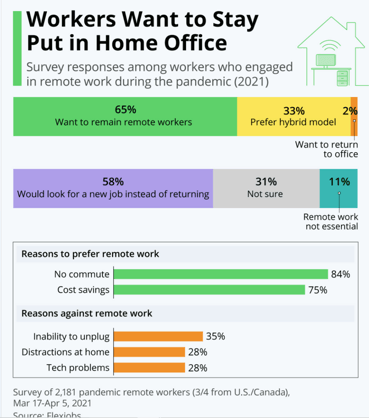After a year of Work from Home, how employees want to work has changed. 65% of employees want to remain remote workers. Another 33% prefer a hybrid model, working from home a few days a week according to a new survey out by Flexjobs, gathering opinions of over 2,100 remote workers.
The two main reasons behind the sentiment were clear.
84% do not want to commute to work. Employees prefer the commute from the bedroom to the home office, the dining room table, or wherever they call the "home office."
75% are enjoying the cost savings, or pay raise, depending on your perspective, that comes with staying home to work. Less money spent eating out, less spent on fuel, bus/train fare, lunch, less on wardrobe, etc.
58% of this group now consider the "benefit" of working from home so crucial that they would look for a new job instead of returning to a pre-COVID office environment.
Of course, that is easier to say than to do, but the message is worth considering.
Employees have discovered that they can be effective in their roles working from home, among other perks, and no longer see enough benefit in being at the office. The financial and quality of life improvements that come with living in PJ bottoms and bunny slippers all day and still being able to get stuff done are just too compelling.
Working from Home Isn’t Perfect
Working from home is not perfect; it comes with some challenges identified in the survey.
Employees voiced a common concern with working from home, not being able to unplug from work.
While the short commute from the bedroom appreciated, the inability to separate the place work gets done from the home space introduces challenges for 35% of those surveyed.
Experiencing distractions while working from home, at 28%, was another element employees surveyed found challenging.
It is not hard to imagine what some of those distractions might be, especially for employees who cannot create a dedicated quiet space for work at home. Children attending school via distance learning, pets, and spouses working from home all come to mind with some of the challenges these can present.
From the employer's perspective, beyond evaluating new ideas like downsizing or eliminating the office, this survey points out new stresses on organizations with a remote workforce.
The Technical Challenge at Home
28% of those surveyed said that one negative aspect of working from home deals with added technical problems.
The survey finding makes logical sense. There are more technology components involved in delivering a successful work experience when working from home. Many of these new elements are not the responsibility of the company IT department. Responsibility for supporting everything within the home network falls to the employee and maybe a tech-savvy relative.
Expanding beyond the corporate network to home networks, IT problems are more varied, making them more challenging. The types and brands of home IT equipment are more varied while the travel distance to support employees has increased. Outside of the office, employees can lose the benefit of unofficial IT support offered by those sitting nearby
In short, there is more to manage, less visibility, more variation, more distance, and no additional IT people to help. A perfect recipe for the surveyed response given by employees reporting that dealing with technical problems is one reason not to work from home.
Remote workers are harder to physically get to for IT personnel when something needs to be fixed or replaced in person than working in the same building as the IT team. It turns out there is still a commute of sorts; it just moved to IT department field techs traveling to employee's homes or a nearby Starbucks to render assistance when remote support is not an option.
Many companies have taken the policy that it is the employees' role to own support for their own home IT equipment which seems reasonable. In reality, these policies get tested when an employee working on a critical project has a problem with their home network preventing them from being productive.
While officially IT does not support home networks, the reality is it is an unofficial necessity in some cases to enable employees to work productively.
These elements contribute to the pain felt by employees when technical challenges occur and the increased wait times while the issues get resolved.
How Virtual Desktops Help
Virtual desktops continue to be an effective option to deliver an excellent PC-like experience for work from home employees while simplifying IT management efforts, reducing resolution times, and eliminating the need for staffing increases to meet increasing IT support demands.
There are some unique paths some companies have put in place to embrace the capabilities of virtual desktops and the simplification these environments can provide.
One financial services firm provides new employees with a menu of IT equipment to select from based on their role as part of the new employee onboarding process. The equipment chosen off the menu is pre-provisioned, asset tagged, etc., by a vendor-partner and delivered to the new employee's home.
Equipment replacement, upgrades, etc., are all managed by the vendor, giving the IT department time to focus on other areas. With this model, IT can maintain standards and maintain appropriate training to deliver adequate support. Employees feel better about the experience because they get to have a hand in selecting the tools they will use to do their work. IT can reduce the complexity a bit and provide a better, more productive end-user experience.
Other innovative companies we work with have extra equipment (mice, monitors, computers, etc.) stored central to their remote employees, allowing them to replace damaged equipment and maintain productivity. At the same time, IT handles the logistics of servicing dead equipment. Hoteling at one of the office locations is an option if there is a problem with the home environment that will take an extended time to fix.
Virtual desktops deliver the applications employees need, and the pre-configured, hot-swap hardware makes management and logistics easy. With these systems in place, IT Support costs have maintained or decreased their pre-COVID levels while maintaining or improving the employee's ability to work.
An engineering firm uses virtual desktops to protect intellectual property and expand their staffing options with VDI outside of their office locations to take advantage of more diverse pools of talent that do not want to move to cities with office locations.
Employees like working from home on their terms. While benefits more than outweigh the drawbacks for a large portion of the working population, there are ways to minimize the potential impact of some of the potential disadvantages considerably.
Technologies like VDI allow employees to work remotely and be productive with a better end-user experience than a legacy VPN connection can provide. The improved management and delivery capabilities will enable IT to support a diverse set of endpoints, including PCs, Macs, Chromebooks, iOS, and Android devices, in its evolution over the last 25 years.
This technology allows employees who can work from home to work from home and meet all security, intellectual property, governance, and compliance requirements and standards.
Great employees are hard to find and can be harder to keep, but the decision of where an employee should work post-COVID does not have to be a potential show stopper.
IT can be equipped with a guaranteed VDI experience to meet these use cases and protect the valuable talent that makes companies successful.
If you are new to VDI or are not having a positive experience with virtual desktops, there is a solution. Whitehat Virtual can guarantee your success on the path to a great VDI experience that will allow employees to work anywhere in the world with an Internet connection where they can best serve the company.
For most companies out there, these "superpowers" can be available in under a week, though company size and applications can undoubtedly impact the timeline. Read more about the 15 superpowers you can get with VDI here.
Then see what the future could look like for your organization. Contact us today for a demo.
Source: https://www.statista.com/chart/24714/survey-on-pandemic-remote-work-us/





Leave Comment